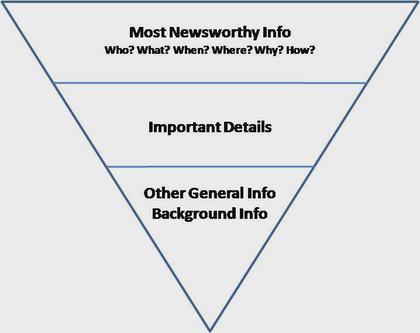Imagine sitting at your desk, staring at yet another article filled with information but devoid of personality or life.
That was me today. And the worst part? I was the one who had written it.
Before cranking out that block of stale prose, I had spent hours scouring the web for inspiration, but every article I found was written in the same cold, detached style. I was frustrated, but I couldn’t quite identify the root cause of my malaise.
All of a sudden, my six-year-old burst into the room, bringing her infectious energy along with her. She jumped onto my lap, looking for something entertaining on my screens.
When she found nothing but my text editor, she declared, “I’m bored.”
“Me too,” I said.
“Why are you bored?”
I chuckled, ruffling her hair. “Oh, I’m just tired of reading and writing the same thing over and over again. Every article I’ve read today is the same; they have no… personality.”
“Why’s it the same?”
As I tried to explain the concept of the inverted pyramid to my six-year-old, I couldn’t help but feel a growing dissatisfaction. Why did journalism have to be so formulaic? As a software engineer, I appreciate the importance of structure and consistency, but something about the inverted pyramid strips the soul from the stories it attempts to elucidate.
The Inverted Pyramid Style
The inverted pyramid is a method journalists use to present information in a hierarchical order, starting with the most essential details and gradually moving to the least important ones. It was designed to make it easy for a consumer to grasp the main points of a story quickly and efficiently in an age of expensive telegraph technology.
Blame The Telegraph

(Yeah, yeah, the photo above is from the 50s—sue me.)
Before the telegraph was invented in the mid-19th century, stories were narrated traditionally, and the pace was slow.
The telegraph changed everything, bringing a new way of communication that was fast but expensive and sometimes unreliable. This forced news organizations to adopt a concise and objective writing style, stripping away opinions and extraneous details.
This style marked a significant shift from the previous storytelling approach and laid the foundation for modern news writing.
Technology has clearly moved on by about six generations since the telegraph. But largely, we are using those same habits and formulas, which come from the telegraph era. So that is strange in and of itself. So that’s why we use the inverted pyramid now. And actually, there’s not really a reason for it anymore.
Shirish Kulkarni - DCN & MobileGroove Interview Series, June 2021
How To Write An Inverted Pyramid

- Start with the cold facts—who, what, when, where, why, and how.
- Move on to vital details that support and add context to the main points.
- Finally, conclude the story with background information, anecdotes, or other less critical details.
Here’s a fictional example of a typical news story using the inverted pyramid style. You’ve read a thousand of these, especially in finance:
MoonTech Inc. Propelled By Retail Mania
Shares of MoonTech Inc. skyrocketed today as a short squeeze sent the stock price soaring by 7,200%, causing significant losses for short-sellers and delighting retail investors.
The meteoric rise began after a popular investing forum uncovered a massive short position held by hedge funds, sparking a coordinated buying spree to drive up the price. Trading volume surged, and the stock reached a record high, forcing short-sellers to buy back their shares at a loss to cover their positions.
MoonTech, a failing brick-and-mortar retailer that initially specialized in lunar-themed novelty items, has pivoted to focus on space tourism and satellite technology, further fueling investor enthusiasm. The company’s founder recently won a local pie-eating contest, consuming 25 pies in 10 minutes. This coincided with a 10% uptick in the share price of PieTech International, a company specializing in automated pie-making machinery.
—YawnFinance, 2023
Everything Wrong With The Inverted Pyramid
Facts are important, but the inverted pyramid prioritizes clinical data over all else, including narrative, context, emotion, tone, etc. It is a methodical machine that pushes critical information to the forefront, but in doing so, it robs the story of depth, leaving a shallow and disconnected account in its wake.
Audiences crave authenticity and relatability, and this traditional approach seems painfully out of touch. We are drawn to stories that resonate with us on a deeper level, reflecting our reality, not just industry norms. We want to connect with the stories we read, not merely consume them.
As I pondered this, I realized that the inverted pyramid trains us to think that the beginning of an article is the only thing that holds any value. We are constantly reminded that attention spans are dwindling in this digital age (it turns out that’s probably nonsense, but I digress), so the inverted pyramid gives the reader what they want before the get bored.
However, I contend that this writing style only serves to erode our ability to engage with the content we consume. Instead of delving into the heart of a story, we are conditioned to skim the surface and move on, never grasping the richness and nuance that may lie beneath.
I’m no journalistic hero out to save the world from mediocrity, but I can at least make a difference on my small corner of the internet. As I write my next blog post, I will strive for a more thoughtful, engaging approach that will resonate with my readers.
Next post? Hell, why not start with this one.
So, with my daughter playing nearby, I began to write this post, not in the cold, sterile manner of the inverted pyramid, but with passion, heart, and purpose.
Now, you might be thinking, “Sure, that sounds great, but who really gives a shit?” That’s fair, but you know what? Even if I don’t inspire a movement, at least I’ll be doing something to fight off the boredom as I write.
And hey, who knows? Maybe my stories will inspire someone to think differently about how we share the narratives that shape our world.